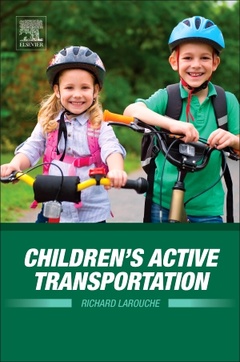Children’s Active Transportation
Auteur : Larouche Richard

Children?s Active Transportation is a rigorous and comprehensive examination of the current research and interventions on active transportation for children and youth. As the travel behaviors of these groups tend to be highly routinized, and their mobility faces unique constraints, such as parental restrictions, mandatory school attendance, and the inability to drive a motor vehicle before late adolescence, this book examines the key factors that influence travel behavior among children and youth, providing key insights into lessons learned from current interventions. Readers will find a resource that clearly demonstrates how critical it is for children to develop strong, active transportation habits that carry into adulthood.
1. Introduction
Part 1: Benefits of active transportation in children and youth2. Public health benefits of active transportation3. Environmental benefits of active transportation4. Economic benefits of active transportation
Part 2: Prevalence and correlates of active transportation5. Last child walking?6. Bubble-wrapped generation?7. An ecological model of children’s active transportation 8. Individual correlates of active transportation 9. Interpersonal correlates of active transportation 10. Community factors related to active transportation 11. Built and physical environment correlates of active transportation 12. Policies and their influence on active transportation13. Prevalence and correlates of active transportation in developing countries
Part 3: Active transportation interventions14. Safe Routes to School15. School travel plans 16. Walking school buses 17. Taming traffic to encourage active transportation 18. Active transportation - is the school hiding the forrest?19. Conclusions and recommendations
1) Academic researchers and advanced students in Transportation, Urban Studies, and Public Health, 2) Transportation, Urban Planning, and Public Health planning practitioners, 3) Transportation and Urban Planning public officials such as city managers, policy directors, research managers, etc.
- Discusses the correlates that exist between children’s active transportation using a social and ecological model
- Summarizes active transportation interventions that show what works to increase non-motorized modes of travel in children
- Describes the factors that influence the implementation and effectiveness of interventions
Date de parution : 06-2018
Ouvrage de 306 p.
15x22.8 cm
Thèmes de Children’s Active Transportation :
Mots-clés :
Active transport; Active transportation; Active travel by children; Active travel; Air pollution; Auckland Transport; Benefit-cost analysis; Benefits; Bicycle train; Built environment; Children; Community factors; Contamination; Cost-benefit analysis; Cost-effectiveness; Cycling; Developing countries; Ecological model; Economic benefits; Environmental benefit; Environmental correlates; Gatekeepers; GHG; Green Communities Canada; Greenhouse gas; Health benefits; Health in children and adolescent; Human behaviour; Implementation and evaluation of STP; Independence; Independent mobility; Individual correlates; Interpersonal correlates; Intervention studies; Interventions�active travel; Interventions�child active travel; Interventions; Life cycle; Longitudinal studies; Millennial generation; National policies and programs; Non-motorized travel mode; Parenting; Parents; Physical activity; Physical environment; Play streets; Policy and practice implementation; Policy interventions; Prevalence and correlates; Public health; Public policy; Qualitative and quantitative studies; Residential streets; Road safety skills; Road safety; Rural areas vs urban areas; Safe Routes to School; School bus; School policies and practices; School travel plans; School; School-based communities; Social cohesion; Social-ecological model; Social-ecological; Socioecological framework; Socioecological model; Speed limits; Tailored interventions; Traffic calming; Travel behaviour; Travel strategies; Travel to and from; Walking and cycling; Walking school buses; Walking; WSB coordinators; Young adults
